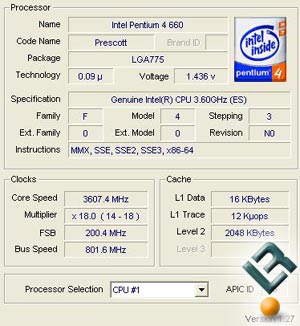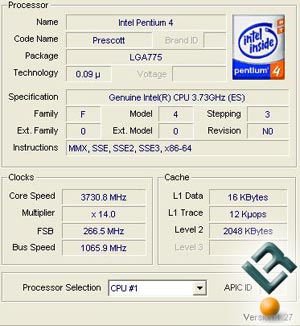Intel 6xx Series CPU's Arrive With New Features!

Over the holiday weekend Intel officially announced the new Pentium 4 Extreme Edition 3.73GHz processor and four processors in their Pentium 4 6XX series (rated as 660 to 630). Today we have the Intel Pentium 4 Extreme Edition at 3.73GHz and the Intel Pentium 4 660 in house for testing. Both of these processors use a new Prescott core that features 2MB of L2 cache and are EMT64 enabled!
When the Prescott first came out the longer pipelines and the increased temperatures from the new 90nm core shocked even the most die hard Intel fans. With the Intel P4 6XX series Intel strived to add performance while at the same time lowering power consumption and temperatures. The new improved core is still manufactured using the 90nm strained silicon production technology just like the original Prescott, which has been in use on the Pentium 4 5XX processors for almost a year now. Since the Prescott core is by no means new or unknown let's jump right into the new features.
The New Features:
- More L2 Cache - Enthusiasts know that more cache means more performance and that is exactly what Intel did on these updated Prescott cores. They doubled the L2 cache in hopes of adding performance. The extra cache means more transistors, and in this case, over 40 million more! This increase in cache also increases the size of the die from 112mm2 to 135mm2. This is the only true "performance" upgrade made to the core this time around.
- EMT64 Enabled - Other than the extra L2 cache the newly launched Pentium 4 6XX processor family offers support for Enhanced Memory 64 Technology or EM64T as many know it by. Since this is nothing more than 64-bit extensions of x86 architecture they are identical to the AMD64 extensions, thus giving us the first AMD vs. Intel battle on the 64-bit Operating System. Now that both Intel and AMD have their 64-bit CPU's out the door and both are fully functional, with the latest public release of Windows XP Professional x64 expect to see this OS completed in the near future!
- Enhanced Power Management - Combination of EIST (Enhanced Intel Speedstep Technology), C1E (Enhanced Halt State), and TM2 (Thermal Monitor 2). In an appropriately designed system, these features can deliver average power savings with little impact to performance by adjusting frequency & voltage. To go a little more in depth, all three technologies offer similar functionality initiated in three different ways. C1E is activated via Halt (idle) instruction execution. EIST operates via OS request based upon CPU load. TM2 operates via processor request based upon the thermal load on the processor.
- Execute Diable Bit Enabled - Intel Execute Disable Bit offers Improved Security when used with Windows XP SP2. With the Execute Disable Bit feature you can be protected from certain types of viruses and buffer overflow exploits. This is similar to AMD's NX technology and Intel has used Execute Disable Bit on the 5XXJ series processors.
The die increase that we talked about above can be seen below via the images of the old Prescott core and the Prescott 2MB with extra cache:
|
|
|
As you can see the new core is very similar to the old core. From just looking at the die pictures it seems as if they just added more cache and made some other minor changes. Below are CPU-Z version 1.27 screen shots of our two processors that we are showing you today.
Both of our processors have 2048 KBytes of L2 Cache and are based on 90nm core technology. Both CPU's also feature a stepping code of 3 and a revision number of N0. The biggest difference between these two processors is the Bus Speed that they run at. The 660 is running at 800MHz, while the 3.73GHz EE is at 1066MHz. One more difference that can't be seen here, but can easily be spotted when you try to pay for these is the price difference. The Intel 3.73GHz Extreme Edition is priced at $999 in 1,000 unit quantities while the Intel 660 rings in at $605.
Many of our readers are enthusiasts that love overclocking so I know what you are thinking by this point -- An extra $400 for 66MHz FSB? I'm sure every overclocker out there just got a big smile on their face and so did we when we noted that the Intel Pentium 4 630 runs at 15 x 200 = 3.0GHz and costs only $224! With a multiplier of 15 and a sub $250 price this processor may easily hit close to a 1066MHz Bus Speed for less than a quarter of the price of the 3.73GHz Extreme Edition. As always you have to have the right hardware to overclock and don't forget it may void your warranty, increase temperatures, and overclocking is not endorsed by Intel. (Who themselves allow for overclocking up to 10% in their own boards BIOS options.)




No comments:
Post a Comment